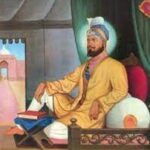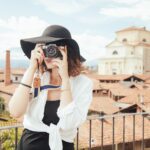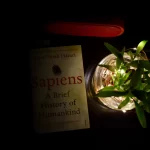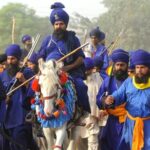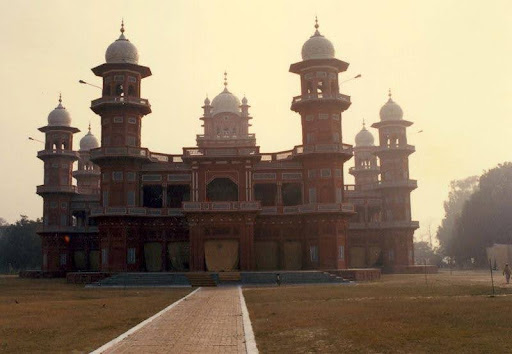Sultanpur Lodhi (31,22N; 75,20E) is a historic town in the Punjab district of Kapurthala. It is around 35 kilometers southeast of Amritsar and spans an area of about 10 square kilometers. It is located about 10 kilometers above the junction of the Beas and Sutlej rivers on the south side of a stream called Kali Bein.
Guru Nanak stayed in Sultanpur Lodhi for several years before embarking on his legendary journey (Udasis) to spread his message throughout the world. His sister, Bibi Nanaki, and her husband, Bhai Jai Ram, lived in this town and worked for Nawab Daulat Khan Lodhi, a feudatory chief who became ruler of the Province of Lahore in the first quarter of the sixteenth century.
Guru Nanak accepted the position of Modi (manager) of Nawab’s provision stores at the insistence of Jai Ram. During that time, a Sangat, or the holy company of disciples, flourished to the point where Bhai Gurdas referred to Sultanpur as the “treasure of God’s devotion” in his Varan (XI.21). Today, Sultanpur Lodhi contains multiple gurdwaras commemorating incidents in Guru Nanak’s life. The main shrine of Sultanpur, Gurdwara Ber Sahib, is located on the bank of the watercourse Kali Bein, half a kilometer west of the old town. Guru Nanak performed his morning ablutions in the Bein before sitting to meditate under a ber (Zizyphus jujuba) tree. Guru Ji meditated at this tree every day for 14 years, nine months, and thirteen days.
Guru Nanak had what is described in the Janam Sakhis as a direct connection with the Divine during one of these ablutions. According to Janam Sakhis, Guru Nanak disappeared into the stream one morning and was not seen for two days. When he resurfaced 2 kilometers upstream at Sant Ghat, his first remarks were, “No one is Hindu, no one is Musalman (Muslim).” Guru Nanak was now prepared to begin his long trips. Gurdwara Ber Sahib is erected on the side of an old ber tree that Guru Nanak is said to have sat in meditation under. Maharaja Jagatjit Singh of Kapurthala constructed the current Gurdwara Ber Sahib structure. Bhai Arjan Singh of Bagarian lay the cornerstone on February 25, 1937, and Lieutenant General Maharaja Yadavinder Singh of Patiala consecrated the Gurdwara on January 26, 1941. The marble-floored hall stands on a high pedestal and is approached through a portico supported by octagonal columns and a tiny entrance gallery.
The sanctum sanctorum, defined by a lofty archway ornamented with floral stucco motifs, lies at the far end, where the Guru Granth Sahib is enthroned on a white marble palak or canopied throne. Aside from regular services and the commemoration of key Sikh events, a big fair is held in November to commemorate Guru Nanak’s birth anniversary. Gurdwara Hatt Sahib, located south of the medieval fortress-like serai, commemorates Guru Nanak’s time as the custodian of Nawab Daulat Khan’s provision stores. The structure consists of a hall with a square sanctum in the center. A square room with wide arched coping and a lotus dome crowned by a gold-plated finial is located above the sanctum. In a glass cabinet, thirteen polished stones of various sizes are believed to represent the weights used by Guru Nanak.
History
Sultanpur Lodhi is a historic city in India. Thought to have been founded around the first century of the current period, it has seen the ups and downs of politics, religion, literature, trade, and commerce throughout more than 20 centuries.
It was one of the key centers of meditation and knowledge for Buddhism from the first to sixth centuries. The city of Sultanpur Lodhi was known as ‘Sarwmanpur’ at the time. During the city’s archaeological digs, several statues, coins, and other similar things were discovered. It is also said that Katiyana wrote the ancient Buddhist text ‘abinav-prastava’ in Sultanpur Lodhi.
In the eighth century, the city grew into a vast empire of Hinduism and Buddhism. Many coins and artifacts from that period have been discovered in this city.
When the Islamic invader Mehmood Gaznavi arrived, his army reduced the Hindu-Buddhist city of Sarwmanpur to flames, and a layer of black soil discovered only a few meters below ground level has left proof of that. Those who had escaped the invading Islamic sword with their lives returned to find their lovely city had been reduced to a barren wasteland. The old book of Aine Akbari places a high value on Sultanpur Lodhi. This city had several royal gardens and pastures back then. Many of those regal structures can still be found today. Hadera, for example, was formerly a stopover for queens on their route to the royal gardens. It was a magnificent structure at the time. It was also a venue for royal family entertainment, hosting dances and other royal functions. Unfortunately, this location is now merely an old building waiting to be demolished.
Sultanpur Lodhi was notable not only for its surroundings and trade but also for its educational institutions at the time. The city was also known as ‘Perran Puri.’


